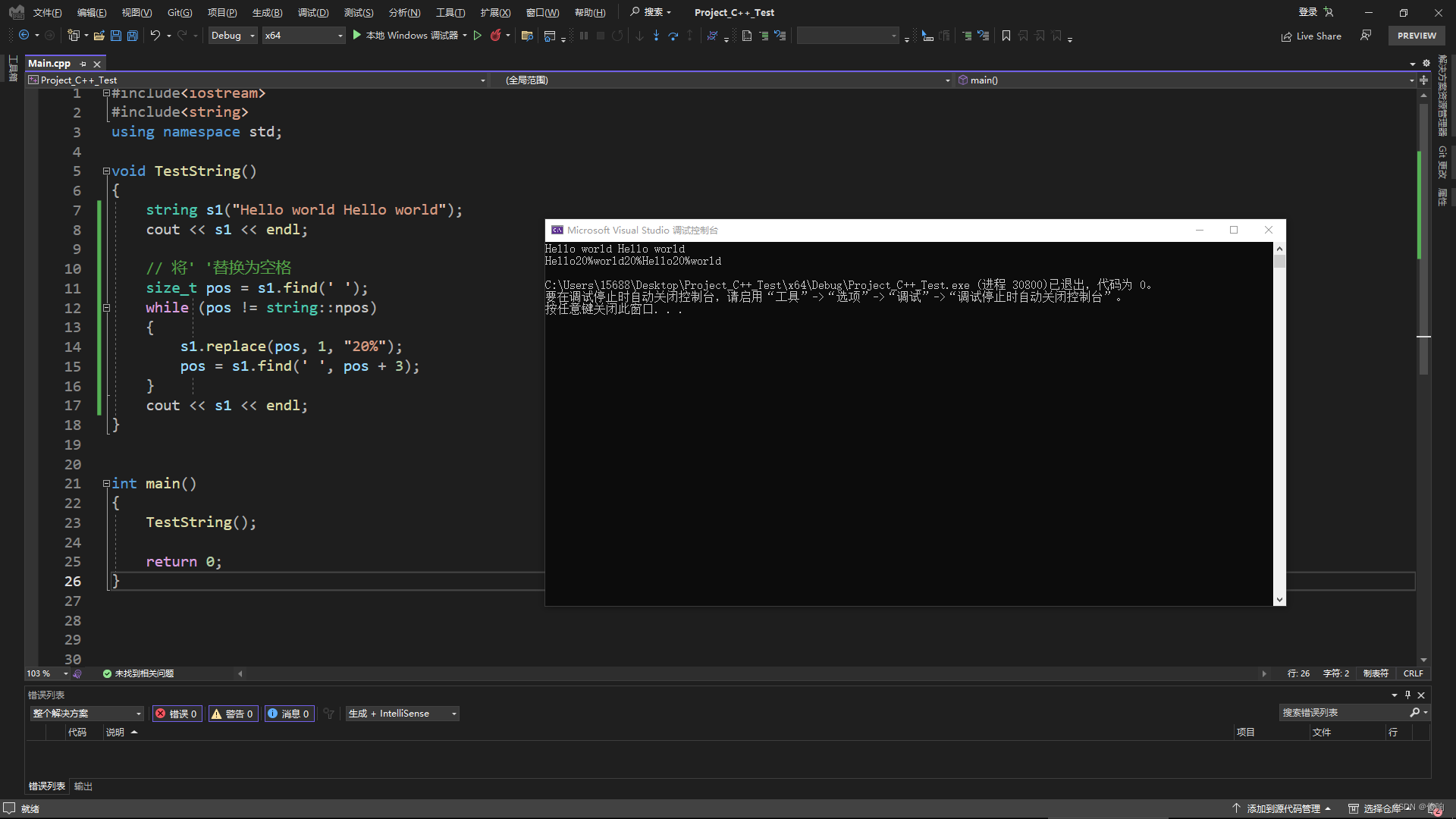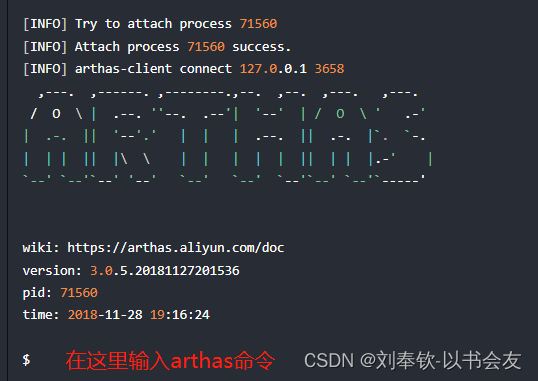《Spring 5.x源码解析之Spring AOP 注解驱动使用及其实现原理》
学好路更宽,钱多少加班。---- mercyblitz
一、前言
大家好,欢迎阅读《Spring 5.x源码解析》系列,本篇作为该系列的第二篇,重点介绍Spring AOP在注解驱动编程模式上的使用及其实现原理。文章内容基于小马哥讲 Spring AOP 编程思想以及Spring源码深度解析(第2版)。笔者多次阅读上述学习资料,形成个人关于Spring的知识总结,希望能帮助各位小伙伴!
二、本文概览
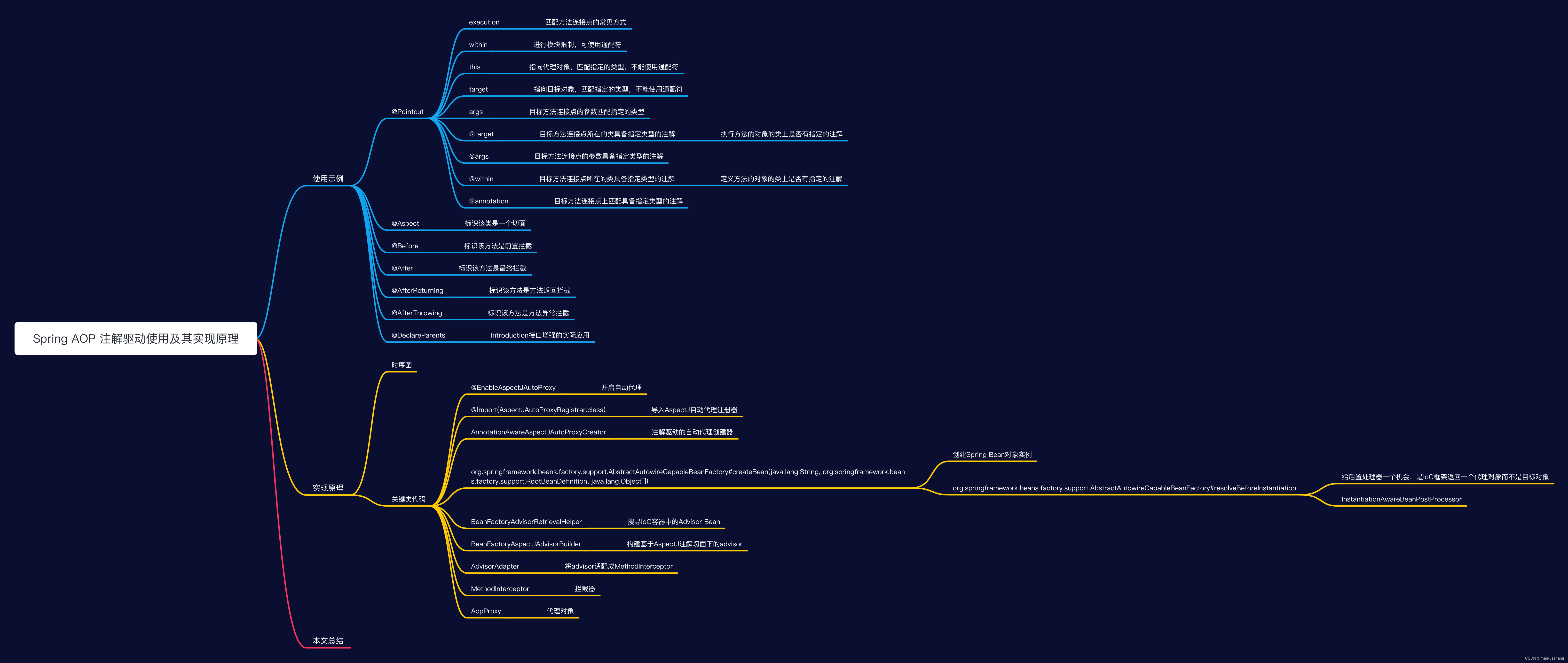
三、使用示例
在本节,我们详细介绍Spring AOP所支持的AspectJ注解使用,在目标方法拦截上介绍@Before、@After、@AfterReturning、@AfterThrowing、@Around、@DeclareParents以及在切入点表达式上介绍execution、within、target、this、args、@args、@target、@within、@annotation的使用
1、@Aspect
该注解的作用就是定义该类是一个切面,在Spring IoC容器会根据Aspect标记拿出该类,创建对应的Advisor,详细动作会在下节实现原理说。
2、AOP通知注解使用
Spring支持AspectJ拦截注解包括@Before、@After、@AfterReturning、@AfterThrowing、@Around,下面简单介绍下他们的作用以及使用方式:
- @Before: 该注解的作用是定义连接点的前置通知方法,在目标方法调用前执行
- @After: 该注解的作用是定义连接点的最终通知方法,在目标方法执行后执行(目标方法正常或异常情况均会执行)
- @AfterReturning: 该注解的作用是定义连接点的后置返回通知方法,在目标方法成功返回后执行
- @AfterThrowing: 该注解的作用是定义在连接点的后置异常返回通知方法,在目标方法执行异常后执行
- @Around: 环绕通知,可以在目标方法执行前后任意时机执行,目标的方法调用是方法内主动去调用,而上面四个注解是被动调用。
下面看下他们的使用示例:
- 切面以及通知定义
package com.markus.spring.aop.feature.blog.aspect;
import org.aspectj.lang.ProceedingJoinPoint;
import org.aspectj.lang.annotation.*;
/**
* @author: markus
* @date: 2022/11/29 1:16 PM
* @Description: 前置方法拦截
* @Blog: http://markuszhang.com
* It's my honor to share what I've learned with you!
*/
@Aspect
public class AspectJAnnotationConfig {
@Before(value = "target(com.markus.aop.overview.EchoService)")
public void before() {
System.out.println("这是前置通知");
}
@After(value = "target(com.markus.aop.overview.EchoService)")
public void after() {
System.out.println("这是方法最终通知");
}
@AfterReturning(value = "target(com.markus.aop.overview.EchoService)")
public void afterReturning() {
System.out.println("这是方法返回通知");
}
@AfterThrowing(value = "target(com.markus.aop.overview.EchoService)")
public void afterThrowing() {
System.out.println("这是方法异常通知");
}
@Around(value = "target(com.markus.aop.overview.EchoService)")
public Object around(ProceedingJoinPoint pjp) throws Throwable {
System.out.println("这是方法环绕前置通知");
try {
Object obj = pjp.proceed();
System.out.println("这是方法环绕返回通知");
return obj;
} catch (Throwable e) {
System.out.println("这是方法环绕异常通知");
throw e;
} finally {
System.out.println("这是方法环绕最终通知");
}
}
}
- 使用
package com.markus.spring.aop.feature.blog;
import com.markus.aop.overview.DefaultEchoService;
import com.markus.aop.overview.EchoService;
import com.markus.spring.aop.feature.blog.aspect.AspectJAnnotationConfig;
import org.springframework.context.annotation.AnnotationConfigApplicationContext;
import org.springframework.context.annotation.Bean;
import org.springframework.context.annotation.EnableAspectJAutoProxy;
/**
* @author: markus
* @date: 2022/11/29 1:20 PM
* @Description: AspectJ注解使用示例
* @Blog: http://markuszhang.com
* It's my honor to share what I've learned with you!
*/
@EnableAspectJAutoProxy
public class AspectJAnnotationDemo {
public static void main(String[] args) {
AnnotationConfigApplicationContext context = new AnnotationConfigApplicationContext();
context.register(AspectJAnnotationDemo.class, AspectJAnnotationConfig.class);
context.refresh();
EchoService echoService = context.getBean(EchoService.class);
echoService.echo("Hello World!");
context.close();
}
@Bean
public EchoService echoService() {
return new DefaultEchoService();
}
}
- 控制台结果
// 方法正常执行
这是方法环绕前置通知
这是前置通知
[echo] Hello World!
这是方法环绕返回通知
这是方法环绕最终通知
这是方法最终通知
这是方法返回通知
Process finished with exit code 0
// 方法异常执行
这是方法环绕前置通知
这是前置通知
这是方法环绕异常通知
这是方法环绕最终通知
这是方法最终通知
这是方法异常通知
Exception in thread "main" java.lang.RuntimeException: 有一定几率异常
at com.markus.aop.overview.DefaultEchoService.echo(DefaultEchoService.java:23)
3、Pointcut切入点表达式
在上面我们看到@Before等等注解内都会有一个value = “target(com.markus.aop.overview.EchoService)”,这个value内容是匹配目标方法的表达式,表达式类型有许多并且也可以通过@Pointcut注解来统一处理,@Before等通知注解引用这个Pointcut即可。下面来逐一介绍下表达式的种类以及其使用方法
- 第一种: execution(modifiers-pattern? ret-type-pattern declare-type-pattern.? name-pattern(param-pattern) throws-pattern?)
- 其中带"?"的表示在表达式中可有可无的
- modifiers-pattern 表示方法的访问类型
- ret-type-pattern 表示方法的返回值类型
- declare-type-pattern 表示方法所在类的类型
- name-pattern 表示方法签名
- param-pattern 表示参数的类型
- throws-pattern 表示异常抛出的类型
- 第二种: within(package),对指定模块下的方法进行匹配
- package 表示模块,可使用通配符
- 第三种: this(package.class),对指定类下的方法进行匹配
- package.class 指向代理对象,不可以使用通配符
- 第四种: target(package.class),对指定类下的方法进行匹配
- package.class 指向目标对象,不可以使用通配符
- 第五种: args(ParameterType,…),对指定参数类型的方法进行匹配
- ParameterType 表示目标方法的参数类型
- 第六种: @target(package.class),执行方法所在的对象是否被目标注解定义
- 执行方法的对象,不一定是定义方法的对象,属于运行时匹配,所以@target会将所有原始对象生成代理,所以慎用!
- 第七种: @within(package.class),定义方法所在的对象是否被目标注解匹配
- 定义方法的对象,属于静态对象
- 第八种: @args(annotationType),目标方法的参数是否被目标注解定义
- annotationType 注解类型,匹配目标方法的参数是否具备目标注解
- 第九种: @annotation(annotationType),目标方法是否被目标注解定义
- annotationType 注解类型
上面介绍了各种表达式的定义以及作用,下面来介绍下他们的使用方法:
- 切面以及表达式定义:
package com.markus.spring.aop.feature.blog.aspect;
import org.aspectj.lang.annotation.Aspect;
import org.aspectj.lang.annotation.Before;
import org.aspectj.lang.annotation.Pointcut;
/**
* @author: markus
* @date: 2022/12/1 1:27 PM
* @Description: 横切点表达式使用演示
* @Blog: http://markuszhang.com
* It's my honor to share what I've learned with you!
*/
@Aspect
public class AspectJPointcutExpressionConfig {
// 表示 方法的访问类型为public 任意返回类型 任意类型的specialReferenceDemo方法 参数可有可无
@Pointcut(value = "execution(public * *.specialReferenceDemo(..))")
public void executionPointcut() {
}
// 表示 匹配在com.markus.spring.aop.feature.blog子模块下的方法
@Pointcut(value = "within(com.markus.spring.aop.feature.blog.domain.*)")
public void withinPointcut() {
}
// 表示 匹配目标对象是com.markus.spring.aop.feature.blog.domain.DefaultPointcutDemo下的方法
@Pointcut(value = "target(com.markus.spring.aop.feature.blog.domain.DefaultPointcutDemo)")
public void targetPointcut() {
}
// 表示 匹配代理对象是com.markus.spring.aop.feature.blog.domain.PointcutDemo下的方法
@Pointcut(value = "this(com.markus.spring.aop.feature.blog.domain.PointcutDemo)")
public void thisPointcut(){
}
// 表示 匹配的方法中参数是ArgsDemo类型
@Pointcut(value = "args(com.markus.spring.aop.feature.blog.domain.ArgsDemo)")
public void argsPointcut(){
}
// 表示 匹配被@EchoInterface定义的对象下的方法
// 它是动态匹配的,会为所有目标对象生成代理,所以慎用!例如AOP动态代理通过cglib实现,遇到被final修饰的bean对象,就会抛出异常
@Pointcut(value = "@target(com.markus.aop.overview.annotation.EchoInterface)")
public void atTargetPointcut(){
}
// 表示 匹配被@EchoInterface定义的对象下的方法
// 与@target不同,它是属于静态匹配,描述为定义方法的对象被@EchoInterface注释
@Pointcut(value = "@within(com.markus.aop.overview.annotation.EchoInterface)")
public void atWithinPointcut(){
}
// 表示 匹配参数所属的类型被@EchoInterface注释的所有方法
@Pointcut(value = "@args(com.markus.aop.overview.annotation.EchoInterface)")
public void atArgsPointcut(){
}
// 表示 匹配被@EchoInterface注释的所有方法
@Pointcut(value = "@annotation(com.markus.aop.overview.annotation.EchoInterface)")
public void atAnnotationPointcut(){
}
@Before("executionPointcut()")
public void executionPointcutBefore() {
System.out.println("this is execution pointcut");
}
@Before("withinPointcut()")
public void withinPointcutBefore() {
System.out.println("this is within pointcut");
}
@Before("targetPointcut()")
public void targetPointcutBefore(){
System.out.println("this is target pointcut");
}
@Before("thisPointcut()")
public void thisPointcutBefore(){
System.out.println("this.is this pointcut");
}
@Before("argsPointcut())")
public void argsPointcutBefore(){
System.out.println("this is args pointcut");
}
@Before("atTargetPointcut()")
public void atTargetPointcutBefore(){
System.out.println("this is @target pointcut");
}
@Before("atWithinPointcut()")
public void atWithinPointcutBefore(){
System.out.println("this is @within pointcut");
}
@Before("atArgsPointcut()")
public void atArgsPointcutBefore(){
System.out.println("this is @args pointcut");
}
@Before("atAnnotationPointcut()")
public void atAnnotationPointBefore(){
System.out.println("this is @annotation pointcut");
}
}
- 客户端
package com.markus.spring.aop.feature.blog;
import com.markus.spring.aop.feature.blog.aspect.AspectJPointcutExpressionConfig;
import com.markus.spring.aop.feature.blog.domain.ArgsDemo;
import com.markus.spring.aop.feature.blog.domain.DefaultPointcutDemo;
import com.markus.spring.aop.feature.blog.domain.PointcutDemo;
import org.springframework.context.annotation.AnnotationConfigApplicationContext;
import org.springframework.context.annotation.Bean;
import org.springframework.context.annotation.EnableAspectJAutoProxy;
/**
* @author: markus
* @date: 2022/12/1 10:24 PM
* @Description: 横切点表达式使用示例
* @Blog: http://markuszhang.com
* It's my honor to share what I've learned with you!
*/
@EnableAspectJAutoProxy
public class AspectJPointcutExpressionDemo {
public static void main(String[] args) {
AnnotationConfigApplicationContext context = new AnnotationConfigApplicationContext();
context.register(AspectJPointcutExpressionDemo.class, AspectJPointcutExpressionConfig.class);
context.refresh();
PointcutDemo pointcutDemo = context.getBean(PointcutDemo.class);
ArgsDemo argsDemo = context.getBean(ArgsDemo.class);
System.out.println("-----start-----");
pointcutDemo.specialReferenceDemo(argsDemo);
System.out.println("-----end-----");
context.close();
}
@Bean
public PointcutDemo pointcutDemo() {
return new DefaultPointcutDemo();
}
@Bean
public ArgsDemo argsDemo() {
return new ArgsDemo("Hello World!");
}
}
- 控制台
-----start-----
this is args pointcut
this is @annotation pointcut
this is @args pointcut
this is @target pointcut
this is @within pointcut
this is execution pointcut
this is target pointcut
this.is this pointcut
this is within pointcut
special reference demo content is
-----end-----
Process finished with exit code 0
4、@DeclareParents-接口增强
@DeclareParents可以声明在切面类里,可以起到对拦截器进行增强的作用。下面通过代码演示一下
- 切面类
@Aspect
public class AspectJDeclareParentsConfig {
@DeclareParents(value = "com.markus.spring.aop.feature.blog.domain.DefaultPointcutDemo", defaultImpl = DefaultUsageTracked.class)
private UsageTracked usageTracked;
@Before("target(com.markus.spring.aop.feature.blog.domain.PointcutDemo) && this(usageTracked)")
public void before(UsageTracked usageTracked){
usageTracked.echoMethodInvokeCount();
}
}
- 启动类
@EnableAspectJAutoProxy
public class AspectJDeclareParentsDemo {
public static void main(String[] args) {
AnnotationConfigApplicationContext context = new AnnotationConfigApplicationContext();
context.register(AspectJDeclareParentsDemo.class, AspectJDeclareParentsConfig.class);
context.refresh();
PointcutDemo pointcutDemo = context.getBean(PointcutDemo.class);
pointcutDemo.commonDemo("Hello World!");
context.close();
}
@Bean
public PointcutDemo pointcutDemo() {
return new DefaultPointcutDemo();
}
}
- 控制台打印
1
common demo content is Hello World!
Process finished with exit code 0
四、实现原理
1、时序图
注解驱动实现原理时序图流程可分为三部分来看:
- IoC容器启动过程AOP前期准备-注册AnnotationAwareAspectJAutoProxyCreator
- 用户获取指定的Spring Bean-为当前Bean创建代理对象
- 调用Bean的目标方法-采用动态代理,调用目标方法,在其过程中获取匹配的MethodInterceptor并依次调用实现对目标方法的拦截后,最终通过反射调用目标方法
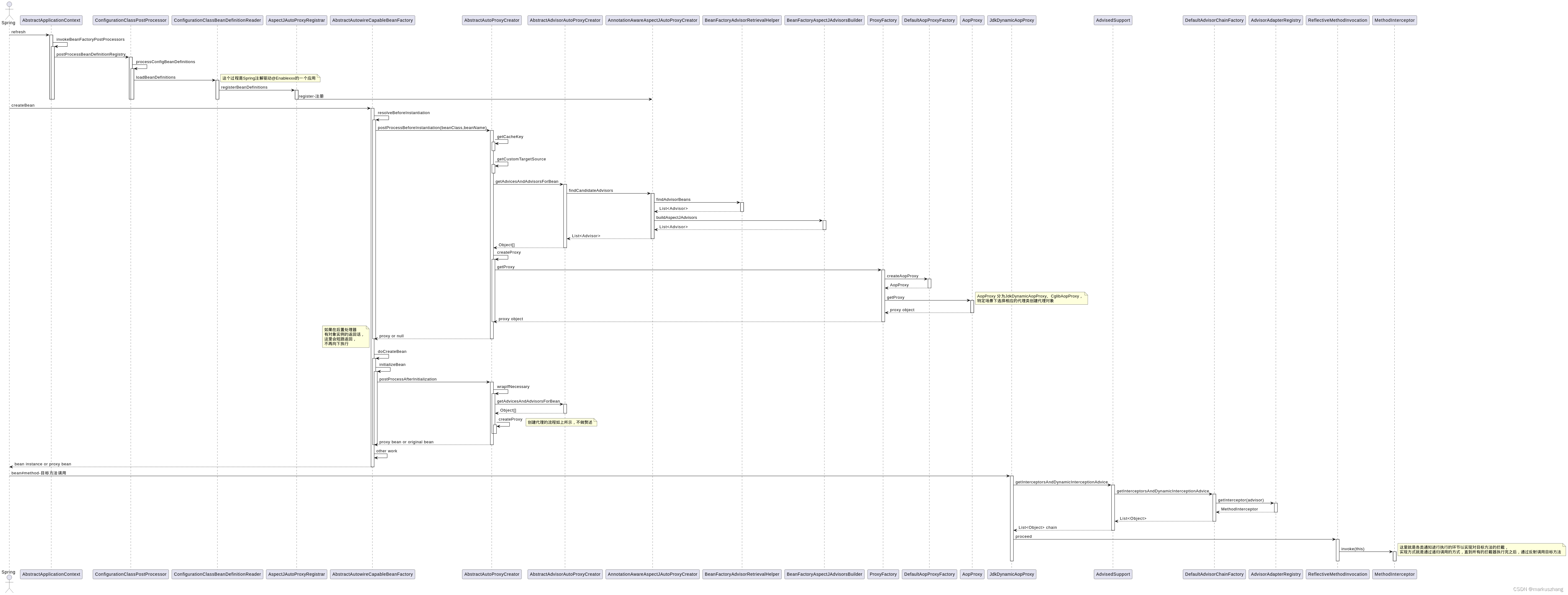
2、关键代码
如上时序图,可以较为清晰的看到Spring是如何给IoC容器中Bean创建代理对象,并且通过代理对象的调用实现对目标方法的拦截。这里再介绍下内部的细节,内容如下:
- Spring是如何开启自动代理的?
- Spring是如何将用户定义的Advice构建为Advisor的?
- Spring是如何创建代理对象的?
- Spring是如何将advisor适配为MethodInterceptor并分配给匹配的方法上的?
- Spring AOP的五种advice执行的先后顺序是如何定义的?
a.Spring是如何开启自动代理的?
Spring通过@EnableAspectJAutoProxy开启AspectJ自动代理,主要是在加载BeanDefinition时动态注册AnnotationAwareAspectJAutoProxyCreator,使的Bean生命周期中创建Bean实例可以有被代理的机会。
- @EnableAspectJAutoProxy
@Target(ElementType.TYPE)
@Retention(RetentionPolicy.RUNTIME)
@Documented
// 重点在这,通过@Import导入具体的注册器类,在该类下注册相应的BeanDefinition 这也是使用@EnableXXX注解驱动的大致逻辑
@Import(AspectJAutoProxyRegistrar.class)
// 值得注意的是该注解是要注释到配置类上的
public @interface EnableAspectJAutoProxy {
/**
* Indicate whether subclass-based (CGLIB) proxies are to be created as opposed
* to standard Java interface-based proxies. The default is {@code false}.
* 可以通过该字段标注Spring是采用jdk动态代理还是CGLIB字节码提升创建代理
* true 使用CGLIB
* false 使用标准方式
*/
boolean proxyTargetClass() default false;
/**
* Indicate that the proxy should be exposed by the AOP framework as a {@code ThreadLocal}
* for retrieval via the {@link org.springframework.aop.framework.AopContext} class.
* Off by default, i.e. no guarantees that {@code AopContext} access will work.
* @since 4.3.1
* 标识代理是否被可以被当前线程本地缓存 AopContext#setCurrentProxy(proxy)
*/
boolean exposeProxy() default false;
}
- AspectJAutoProxyRegistrar
// 定义AspectJAutoProxyRegistrar 实现ImportBeanDefinitionRegistrar的registerBeanDefinitions方法,在加载BeanDefinition的时候注册自定义的BeanDefinition
class AspectJAutoProxyRegistrar implements ImportBeanDefinitionRegistrar {
/**
* Register, escalate, and configure the AspectJ auto proxy creator based on the value
* of the @{@link EnableAspectJAutoProxy#proxyTargetClass()} attribute on the importing
* {@code @Configuration} class.
*/
@Override
public void registerBeanDefinitions(
AnnotationMetadata importingClassMetadata, BeanDefinitionRegistry registry) {
// 向BeanDefinitionRegistry中注册AnnotationAwareAspectJAutoProxyCreator
AopConfigUtils.registerAspectJAnnotationAutoProxyCreatorIfNecessary(registry);
AnnotationAttributes enableAspectJAutoProxy =
AnnotationConfigUtils.attributesFor(importingClassMetadata, EnableAspectJAutoProxy.class);
if (enableAspectJAutoProxy != null) {
// @EnableAspectJAutoProxy中的proxyTargetClass配置
if (enableAspectJAutoProxy.getBoolean("proxyTargetClass")) {
AopConfigUtils.forceAutoProxyCreatorToUseClassProxying(registry);
}
// @EnableAspectJAutoProxy中的exposeProxy配置
if (enableAspectJAutoProxy.getBoolean("exposeProxy")) {
AopConfigUtils.forceAutoProxyCreatorToExposeProxy(registry);
}
}
}
}
- AopConfigUtils
@Nullable
// 在@EnableAspectJAutoProxy中cls指的是的AnnotationAwareAspectJAutoProxyCreator
private static BeanDefinition registerOrEscalateApcAsRequired(
Class<?> cls, BeanDefinitionRegistry registry, @Nullable Object source) {
Assert.notNull(registry, "BeanDefinitionRegistry must not be null");
// 处理Spring中自动代理创建器的优先级问题 如果即将被注册的cls比IoC容器中已存在的自动代理创建器有冲突,则选择优先级最高的进行定义
// 优先级从小到大: InfrastructureAdvisorAutoProxyCreator < AspectJAwareAdvisorAutoProxyCreator < AnnotationAwareAspectJAutoProxyCreator
if (registry.containsBeanDefinition(AUTO_PROXY_CREATOR_BEAN_NAME)) {
BeanDefinition apcDefinition = registry.getBeanDefinition(AUTO_PROXY_CREATOR_BEAN_NAME);
if (!cls.getName().equals(apcDefinition.getBeanClassName())) {
int currentPriority = findPriorityForClass(apcDefinition.getBeanClassName());
int requiredPriority = findPriorityForClass(cls);
if (currentPriority < requiredPriority) {
apcDefinition.setBeanClassName(cls.getName());
}
}
return null;
}
// 无优先级冲突,则创建该类的RootBeanDefinition并注册到BeanDefinitionRegistry中
RootBeanDefinition beanDefinition = new RootBeanDefinition(cls);
beanDefinition.setSource(source);
beanDefinition.getPropertyValues().add("order", Ordered.HIGHEST_PRECEDENCE);
beanDefinition.setRole(BeanDefinition.ROLE_INFRASTRUCTURE);
registry.registerBeanDefinition(AUTO_PROXY_CREATOR_BEAN_NAME, beanDefinition);
return beanDefinition;
}
b.Spring是如何将用户定义的Advice构建为Advisor的?
讲述这个问题前,我们先了解下哪些内容可以被Spring认为成Advisor
- IoC容器中注册的Advisor Bean
- IoC容器中注册的Aspect Bean中的Advice method
第一个很好理解,Spring通过依赖查找找到IoC容器注册的Advisor相关Bean,将其加入到List<Advisor>集合中,那第二种Spring是如何进行转换的呢,我们下面来详细了解下
- AbstractAdvisorAutoProxyCreator
@Override
@Nullable
// Spring在给Bean创建代理对象时,会为该Bean查找所有的Advice和Advisor
protected Object[] getAdvicesAndAdvisorsForBean(
Class<?> beanClass, String beanName, @Nullable TargetSource targetSource) {
// 查找所有符合条件的Advisor
List<Advisor> advisors = findEligibleAdvisors(beanClass, beanName);
if (advisors.isEmpty()) {
return DO_NOT_PROXY;
}
return advisors.toArray();
}
// 查找所有符合条件的Advisor
protected List<Advisor> findEligibleAdvisors(Class<?> beanClass, String beanName) {
// 查找所有的Advisor
List<Advisor> candidateAdvisors = findCandidateAdvisors();
// 筛选出符合条件的Advisor
List<Advisor> eligibleAdvisors = findAdvisorsThatCanApply(candidateAdvisors, beanClass, beanName);
// 拓展Advisor,目前在AnnotationAwareAspectJAutoProxyCreator中拓展了此功能,在执行链中增加了ExposeInvocationInterceptor,用于感知目前进行的执行链执行的上下文。
// ExposeInvocationInterceptor拦截器不需要用户感知,只有在AspectJ注解风格下 Spring才会使用
extendAdvisors(eligibleAdvisors);
if (!eligibleAdvisors.isEmpty()) {
eligibleAdvisors = sortAdvisors(eligibleAdvisors);
}
return eligibleAdvisors;
}
// 查询候选的Advisor Bean,子类可以重写此方法来丰富Advisor来源
protected List<Advisor> findCandidateAdvisors() {
Assert.state(this.advisorRetrievalHelper != null, "No BeanFactoryAdvisorRetrievalHelper available");
// 这里面就是通过BeanFactory依赖查找Advisor的相关Bean集合,不做赘述了
return this.advisorRetrievalHelper.findAdvisorBeans();
}
- AnnotationAwareAspectJAutoProxyCreator
@Override
// 重写AbstractAdvisorAutoProxyCreator中的findCandidateAdvisors方法
protected List<Advisor> findCandidateAdvisors() {
// Add all the Spring advisors found according to superclass rules.
// 父类提供的查询规则
List<Advisor> advisors = super.findCandidateAdvisors();
// Build Advisors for all AspectJ aspects in the bean factory.
// 基于AspectJ注解,搜寻其切面下的Advice方法 并转换为Advisor
if (this.aspectJAdvisorsBuilder != null) {
advisors.addAll(this.aspectJAdvisorsBuilder.buildAspectJAdvisors());
}
return advisors;
}
- BeanFactoryAspectJAdvisorBuilderAdapter
public List<Advisor> buildAspectJAdvisors() {
// <1> 找到IoC容所有的Aspect Bean名称
List<String> aspectNames = this.aspectBeanNames;
if (aspectNames == null) {
synchronized (this) {
aspectNames = this.aspectBeanNames;
if (aspectNames == null) {
List<Advisor> advisors = new ArrayList<>();
aspectNames = new ArrayList<>();
// 也是通过依赖查找,是查找到所有的Bean名称集合
String[] beanNames = BeanFactoryUtils.beanNamesForTypeIncludingAncestors(
this.beanFactory, Object.class, true, false);
for (String beanName : beanNames) {
// 遍历所有的Bean名称,排除一些不符合条件的Bean
if (!isEligibleBean(beanName)) {
continue;
}
// We must be careful not to instantiate beans eagerly as in this case they
// would be cached by the Spring container but would not have been weaved.
// 这里作者解释了,为什么采用类型查找,而不是实例查找
Class<?> beanType = this.beanFactory.getType(beanName);
if (beanType == null) {
continue;
}
// 通过AspectJAdvisorFactory判断当前类是否被@Aspect注释
if (this.advisorFactory.isAspect(beanType)) {
aspectNames.add(beanName);
AspectMetadata amd = new AspectMetadata(beanType, beanName);
if (amd.getAjType().getPerClause().getKind() == PerClauseKind.SINGLETON) {
MetadataAwareAspectInstanceFactory factory =
new BeanFactoryAspectInstanceFactory(this.beanFactory, beanName);
// 获取该切面下的所有advisor
List<Advisor> classAdvisors = this.advisorFactory.getAdvisors(factory);
if (this.beanFactory.isSingleton(beanName)) {
// 缓存切面下对应的advisor
this.advisorsCache.put(beanName, classAdvisors);
}
else {
// 缓存切面下对应的实例工厂
this.aspectFactoryCache.put(beanName, factory);
}
advisors.addAll(classAdvisors);
}
else {
// Per target or per this.
if (this.beanFactory.isSingleton(beanName)) {
throw new IllegalArgumentException("Bean with name '" + beanName +
"' is a singleton, but aspect instantiation model is not singleton");
}
// 原型模式
MetadataAwareAspectInstanceFactory factory =
new PrototypeAspectInstanceFactory(this.beanFactory, beanName);
this.aspectFactoryCache.put(beanName, factory);
advisors.addAll(this.advisorFactory.getAdvisors(factory));
}
}
}
this.aspectBeanNames = aspectNames;
return advisors;
}
}
}
if (aspectNames.isEmpty()) {
return Collections.emptyList();
}
// 利用缓存进行性能优化
List<Advisor> advisors = new ArrayList<>();
for (String aspectName : aspectNames) {
List<Advisor> cachedAdvisors = this.advisorsCache.get(aspectName);
if (cachedAdvisors != null) {
advisors.addAll(cachedAdvisors);
}
else {
MetadataAwareAspectInstanceFactory factory = this.aspectFactoryCache.get(aspectName);
advisors.addAll(this.advisorFactory.getAdvisors(factory));
}
}
return advisors;
}
- ReflectiveAspectJAdvisorFactory
@Override
// 通过AspectInstanceFactory获取Advisor集合
public List<Advisor> getAdvisors(MetadataAwareAspectInstanceFactory aspectInstanceFactory) {
Class<?> aspectClass = aspectInstanceFactory.getAspectMetadata().getAspectClass();
String aspectName = aspectInstanceFactory.getAspectMetadata().getAspectName();
// <1> 校验切面类
validate(aspectClass);
// We need to wrap the MetadataAwareAspectInstanceFactory with a decorator
// so that it will only instantiate once.
// 装饰者模式-增强AspectJInstanceFactory功能,使得该切面只被实例化一次
MetadataAwareAspectInstanceFactory lazySingletonAspectInstanceFactory =
new LazySingletonAspectInstanceFactoryDecorator(aspectInstanceFactory);
List<Advisor> advisors = new ArrayList<>();
// <2> 查找该类下所有的非Pointcut注解的方法
for (Method method : getAdvisorMethods(aspectClass)) {
// <3> 获取Advisor
Advisor advisor = getAdvisor(method, lazySingletonAspectInstanceFactory, advisors.size(), aspectName);
if (advisor != null) {
advisors.add(advisor);
}
}
// If it's a per target aspect, emit the dummy instantiating aspect.
// <4> 如果切面是延迟初始化特性,则在执行链最开始增加一个advisor,直到目标方法被调用时再被初始化
if (!advisors.isEmpty() && lazySingletonAspectInstanceFactory.getAspectMetadata().isLazilyInstantiated()) {
Advisor instantiationAdvisor = new SyntheticInstantiationAdvisor(lazySingletonAspectInstanceFactory);
advisors.add(0, instantiationAdvisor);
}
// Find introduction fields.
// <5> 接口增强特性-@DeclareParents字段为拦截器增强动作
for (Field field : aspectClass.getDeclaredFields()) {
Advisor advisor = getDeclareParentsAdvisor(field);
if (advisor != null) {
advisors.add(advisor);
}
}
// <6> 返回所有的Advisor数据
return advisors;
}
private List<Method> getAdvisorMethods(Class<?> aspectClass) {
final List<Method> methods = new ArrayList<>();
// 通过反射 查找Advisor目标方法,通过排除Pointcut注解方式实现
ReflectionUtils.doWithMethods(aspectClass, method -> {
// Exclude pointcuts
if (AnnotationUtils.getAnnotation(method, Pointcut.class) == null) {
methods.add(method);
}
}, ReflectionUtils.USER_DECLARED_METHODS);
methods.sort(METHOD_COMPARATOR);
return methods;
}
@Override
@Nullable
public Advisor getAdvisor(Method candidateAdviceMethod, MetadataAwareAspectInstanceFactory aspectInstanceFactory,
int declarationOrderInAspect, String aspectName) {
validate(aspectInstanceFactory.getAspectMetadata().getAspectClass());
// 根据候选Advice方法的AspectJ注解 构建AspectJExpressionPointcut
AspectJExpressionPointcut expressionPointcut = getPointcut(
candidateAdviceMethod, aspectInstanceFactory.getAspectMetadata().getAspectClass());
if (expressionPointcut == null) {
return null;
}
// 将方法包装为Advisor并返回
return new InstantiationModelAwarePointcutAdvisorImpl(expressionPointcut, candidateAdviceMethod,
this, aspectInstanceFactory, declarationOrderInAspect, aspectName);
}
c.Spring是如何创建代理对象的?
Spring创建代理对象是通过ProxyFactory、AopProxyFactory、AopProxy协作创建代理对象
- AbstractAutoProxyCreator
protected Object createProxy(Class<?> beanClass, @Nullable String beanName,
@Nullable Object[] specificInterceptors, TargetSource targetSource) {
if (this.beanFactory instanceof ConfigurableListableBeanFactory) {
// 一般BeanFactory都会走这个流程 将当前Bean的原始类填充到该Bean的BeanDefinition中
AutoProxyUtils.exposeTargetClass((ConfigurableListableBeanFactory) this.beanFactory, beanName, beanClass);
}
// <1> ProxyFactory
ProxyFactory proxyFactory = new ProxyFactory();
// <2> 将ProxyConfig信息拷贝一份
proxyFactory.copyFrom(this);
// <3> 是否代理目标类 如果为true 则直接采用CGLIB字节码提升,便没有必要再计算代理接口了。CGLIB是通过生成目标类的子类来进行字节码提升的
if (!proxyFactory.isProxyTargetClass()) {
// <3.1> 是否应该代理目标类 也就是是否采用CGLIB,这是通过BeanDefinition的Attribute属性决定的
if (shouldProxyTargetClass(beanClass, beanName)) {
proxyFactory.setProxyTargetClass(true);
}
else {
// <3.2> 计算所要代理的接口
evaluateProxyInterfaces(beanClass, proxyFactory);
}
}
// <4> 获取Advisor数组对象
Advisor[] advisors = buildAdvisors(beanName, specificInterceptors);
// <5> 将Advisor对象添加至代理工厂
proxyFactory.addAdvisors(advisors);
// <6> 设置目标源
proxyFactory.setTargetSource(targetSource);
// <7> 自定义代理工厂-子类去扩展
customizeProxyFactory(proxyFactory);
// <8> 设置代理工厂是否被冻结
proxyFactory.setFrozen(this.freezeProxy);
// <9> 在Advisor匹配时 是否跳过类过滤(ClassFilter)检查
if (advisorsPreFiltered()) {
proxyFactory.setPreFiltered(true);
}
// <10> 最终创建代理对象并返回
return proxyFactory.getProxy(getProxyClassLoader());
}
// 构建Advisor数组
protected Advisor[] buildAdvisors(@Nullable String beanName, @Nullable Object[] specificInterceptors) {
// Handle prototypes correctly...
// 处理指定的拦截器
Advisor[] commonInterceptors = resolveInterceptorNames();
List<Object> allInterceptors = new ArrayList<>();
if (specificInterceptors != null) {
allInterceptors.addAll(Arrays.asList(specificInterceptors));
if (commonInterceptors.length > 0) {
if (this.applyCommonInterceptorsFirst) {
allInterceptors.addAll(0, Arrays.asList(commonInterceptors));
}
else {
allInterceptors.addAll(Arrays.asList(commonInterceptors));
}
}
}
if (logger.isTraceEnabled()) {
int nrOfCommonInterceptors = commonInterceptors.length;
int nrOfSpecificInterceptors = (specificInterceptors != null ? specificInterceptors.length : 0);
logger.trace("Creating implicit proxy for bean '" + beanName + "' with " + nrOfCommonInterceptors +
" common interceptors and " + nrOfSpecificInterceptors + " specific interceptors");
}
Advisor[] advisors = new Advisor[allInterceptors.size()];
for (int i = 0; i < allInterceptors.size(); i++) {
// 通过AdvisorAdapterRegistry将specificInterceptors适配为Advisor
advisors[i] = this.advisorAdapterRegistry.wrap(allInterceptors.get(i));
}
return advisors;
}
- ProxyProcessorSupport
// 计算需要代理的接口
protected void evaluateProxyInterfaces(Class<?> beanClass, ProxyFactory proxyFactory) {
// 获取该类的所有接口
Class<?>[] targetInterfaces = ClassUtils.getAllInterfacesForClass(beanClass, getProxyClassLoader());
boolean hasReasonableProxyInterface = false;
for (Class<?> ifc : targetInterfaces) {
// 过滤出非Spring内部配置、基建接口并且该接口非标记接口
if (!isConfigurationCallbackInterface(ifc) && !isInternalLanguageInterface(ifc) &&
ifc.getMethods().length > 0) {
hasReasonableProxyInterface = true;
break;
}
}
if (hasReasonableProxyInterface) {
// Must allow for introductions; can't just set interfaces to the target's interfaces only.
// 将可以被代理的接口 添加至ProxyFactory中
for (Class<?> ifc : targetInterfaces) {
proxyFactory.addInterface(ifc);
}
}
else {
// 否则 只能代理目标类
proxyFactory.setProxyTargetClass(true);
}
}
// 创建AOP代理类
protected final synchronized AopProxy createAopProxy() {
if (!this.active) {
activate();
}
// 通过AopProxyFactory创建具体的AOP代理
// AopProxyFactory 默认实现: DefaultAopProxyFactory
// AopProxy : JdkDynamicAopProxy、CglibAopProxy
return getAopProxyFactory().createAopProxy(this);
}
- DefaultAopProxyFactory
// 三种条件满足其一,则使用CglibAopProxy
// 1. 配置优化标识被设置为true
// 2. 代理目标类标识被设置为true
// 3. 无代理接口可被使用
// 其余情况均使用JdkDynamicAopProxy
@Override
public AopProxy createAopProxy(AdvisedSupport config) throws AopConfigException {
if (config.isOptimize() || config.isProxyTargetClass() || hasNoUserSuppliedProxyInterfaces(config)) {
Class<?> targetClass = config.getTargetClass();
if (targetClass == null) {
throw new AopConfigException("TargetSource cannot determine target class: " +
"Either an interface or a target is required for proxy creation.");
}
if (targetClass.isInterface() || Proxy.isProxyClass(targetClass)) {
return new JdkDynamicAopProxy(config);
}
return new ObjenesisCglibAopProxy(config);
}
else {
return new JdkDynamicAopProxy(config);
}
}
剩余的采用JdkDynamicAopProxy以及CglibAopProxy创建代理的步骤就不赘述了。JdkDynamicAopProxy则是使用Proxy.newProxyInstance(xx),CglibAopProxy则是使用Enhancer。
d.Spring是如何将advisor适配为MethodInterceptor并分配给匹配的方法上的?
我们以JdkDynamicAopProxy创建的代理对象为例,介绍该问题。一句话概括就是在调用目标方法时,代理对象进行目标方法的拦截回调invoke,invoke环节里先获取MethodInterceptor执行链,执行链的获取是通过DefaultAdvisorChainFactory获取,在AdvisedSupport中通过PointcutAdvisor筛选出目标的MethodInterceptor获取最终的拦截器执行链,最终通过MethodInvocation#proceed()调用,实现拦截器对目标方法的拦截,内部通过递归调用。
- JdkDynamicAopProxy
@Override
@Nullable
// 调用目标方法的回调
public Object invoke(Object proxy, Method method, Object[] args) throws Throwable {
Object oldProxy = null;
boolean setProxyContext = false;
// 获取代理配置的目标源
TargetSource targetSource = this.advised.targetSource;
Object target = null;
try {
// 没有定义equal方法并且当前调用的还是equals方法,则调用代理类实现的equals方法
if (!this.equalsDefined && AopUtils.isEqualsMethod(method)) {
// The target does not implement the equals(Object) method itself.
return equals(args[0]);
}
// 和equals方法一样的情况
else if (!this.hashCodeDefined && AopUtils.isHashCodeMethod(method)) {
// The target does not implement the hashCode() method itself.
return hashCode();
}
// 装饰器代理 确定给定实例的最终目标类
else if (method.getDeclaringClass() == DecoratingProxy.class) {
// There is only getDecoratedClass() declared -> dispatch to proxy config.
return AopProxyUtils.ultimateTargetClass(this.advised);
}
// Advise接口上的方法调用
else if (!this.advised.opaque && method.getDeclaringClass().isInterface() &&
method.getDeclaringClass().isAssignableFrom(Advised.class)) {
// Service invocations on ProxyConfig with the proxy config...
return AopUtils.invokeJoinpointUsingReflection(this.advised, method, args);
}
// 上面说的四种情况一般不会进入,一般情况下都是如下流程
Object retVal;
// 1. 是否曝光代理类
if (this.advised.exposeProxy) {
// Make invocation available if necessary.
oldProxy = AopContext.setCurrentProxy(proxy);
setProxyContext = true;
}
// Get as late as possible to minimize the time we "own" the target,
// in case it comes from a pool.
// 获取目标对象
target = targetSource.getTarget();
Class<?> targetClass = (target != null ? target.getClass() : null);
// Get the interception chain for this method.
// 获取该方法的拦截器执行链,这里是将advisor适配为MethodInterceptor并且返回和方法匹配的MethodInterceptor执行链。
List<Object> chain = this.advised.getInterceptorsAndDynamicInterceptionAdvice(method, targetClass);
// Check whether we have any advice. If we don't, we can fallback on direct
// reflective invocation of the target, and avoid creating a MethodInvocation.
if (chain.isEmpty()) {
// We can skip creating a MethodInvocation: just invoke the target directly
// Note that the final invoker must be an InvokerInterceptor so we know it does
// nothing but a reflective operation on the target, and no hot swapping or fancy proxying.
Object[] argsToUse = AopProxyUtils.adaptArgumentsIfNecessary(method, args);
retVal = AopUtils.invokeJoinpointUsingReflection(target, method, argsToUse);
}
else {
// We need to create a method invocation...
// 方法调用前的最后一步: 创建MethodInvocation,它是作为拦截器之间执行传递的媒介
MethodInvocation invocation =
new ReflectiveMethodInvocation(proxy, target, method, args, targetClass, chain);
// Proceed to the joinpoint through the interceptor chain.
// 方法调用,内部通过递归调用实现拦截器对目标方法的拦截
retVal = invocation.proceed();
}
// Massage return value if necessary.
Class<?> returnType = method.getReturnType();
if (retVal != null && retVal == target &&
returnType != Object.class && returnType.isInstance(proxy) &&
!RawTargetAccess.class.isAssignableFrom(method.getDeclaringClass())) {
// Special case: it returned "this" and the return type of the method
// is type-compatible. Note that we can't help if the target sets
// a reference to itself in another returned object.
retVal = proxy;
}
else if (retVal == null && returnType != Void.TYPE && returnType.isPrimitive()) {
throw new AopInvocationException(
"Null return value from advice does not match primitive return type for: " + method);
}
return retVal;
}
finally {
if (target != null && !targetSource.isStatic()) {
// Must have come from TargetSource.
targetSource.releaseTarget(target);
}
if (setProxyContext) {
// Restore old proxy.
AopContext.setCurrentProxy(oldProxy);
}
}
}
- AdvisedSupport
public List<Object> getInterceptorsAndDynamicInterceptionAdvice(Method method, @Nullable Class<?> targetClass) {
MethodCacheKey cacheKey = new MethodCacheKey(method);
// 先去获取缓存,拿到对应的执行链
List<Object> cached = this.methodCache.get(cacheKey);
if (cached == null) {
// 缓存中没有 则通过AdvisorChainFactory获取执行链
cached = this.advisorChainFactory.getInterceptorsAndDynamicInterceptionAdvice(
this, method, targetClass);
// 将执行链添加到缓存中
this.methodCache.put(cacheKey, cached);
}
return cached;
}
- DefaultAdvisorChainFactory
public class DefaultAdvisorChainFactory implements AdvisorChainFactory, Serializable {
@Override
public List<Object> getInterceptorsAndDynamicInterceptionAdvice(
Advised config, Method method, @Nullable Class<?> targetClass) {
// This is somewhat tricky... We have to process introductions first,
// but we need to preserve order in the ultimate list.
// 获取Advisor适配器注册工厂
AdvisorAdapterRegistry registry = GlobalAdvisorAdapterRegistry.getInstance();
// 获取配置中的Advisor
Advisor[] advisors = config.getAdvisors();
List<Object> interceptorList = new ArrayList<>(advisors.length);
Class<?> actualClass = (targetClass != null ? targetClass : method.getDeclaringClass());
Boolean hasIntroductions = null;
for (Advisor advisor : advisors) {
if (advisor instanceof PointcutAdvisor) {
// Add it conditionally.
// 下面这一大串则是将配置中Advisor与当前方法进行匹配,如果匹配的上则加入到执行链中,否则跳过
PointcutAdvisor pointcutAdvisor = (PointcutAdvisor) advisor;
if (config.isPreFiltered() || pointcutAdvisor.getPointcut().getClassFilter().matches(actualClass)) {
MethodMatcher mm = pointcutAdvisor.getPointcut().getMethodMatcher();
boolean match;
if (mm instanceof IntroductionAwareMethodMatcher) {
if (hasIntroductions == null) {
hasIntroductions = hasMatchingIntroductions(advisors, actualClass);
}
match = ((IntroductionAwareMethodMatcher) mm).matches(method, actualClass, hasIntroductions);
}
else {
match = mm.matches(method, actualClass);
}
if (match) {
MethodInterceptor[] interceptors = registry.getInterceptors(advisor);
if (mm.isRuntime()) {
// Creating a new object instance in the getInterceptors() method
// isn't a problem as we normally cache created chains.
for (MethodInterceptor interceptor : interceptors) {
// 运行时匹配,创建一个新对象,对象内容包含拦截器和方法匹配器
interceptorList.add(new InterceptorAndDynamicMethodMatcher(interceptor, mm));
}
}
else {
interceptorList.addAll(Arrays.asList(interceptors));
}
}
}
}
else if (advisor instanceof IntroductionAdvisor) {
// 需要处理接口增强Advisor
IntroductionAdvisor ia = (IntroductionAdvisor) advisor;
if (config.isPreFiltered() || ia.getClassFilter().matches(actualClass)) {
Interceptor[] interceptors = registry.getInterceptors(advisor);
interceptorList.addAll(Arrays.asList(interceptors));
}
}
else {
// 其他类型的Advisor
Interceptor[] interceptors = registry.getInterceptors(advisor);
interceptorList.addAll(Arrays.asList(interceptors));
}
}
return interceptorList;
}
/**
* Determine whether the Advisors contain matching introductions.
*/
private static boolean hasMatchingIntroductions(Advisor[] advisors, Class<?> actualClass) {
for (Advisor advisor : advisors) {
if (advisor instanceof IntroductionAdvisor) {
IntroductionAdvisor ia = (IntroductionAdvisor) advisor;
if (ia.getClassFilter().matches(actualClass)) {
return true;
}
}
}
return false;
}
}
- ReflectiveMethoInvocation
@Override
@Nullable
public Object proceed() throws Throwable {
// We start with an index of -1 and increment early.
if (this.currentInterceptorIndex == this.interceptorsAndDynamicMethodMatchers.size() - 1) {
// 执行目标连接点
return invokeJoinpoint();
}
Object interceptorOrInterceptionAdvice =
this.interceptorsAndDynamicMethodMatchers.get(++this.currentInterceptorIndex);
if (interceptorOrInterceptionAdvice instanceof InterceptorAndDynamicMethodMatcher) {
// Evaluate dynamic method matcher here: static part will already have
// been evaluated and found to match.
InterceptorAndDynamicMethodMatcher dm =
(InterceptorAndDynamicMethodMatcher) interceptorOrInterceptionAdvice;
Class<?> targetClass = (this.targetClass != null ? this.targetClass : this.method.getDeclaringClass());
if (dm.methodMatcher.matches(this.method, targetClass, this.arguments)) {
return dm.interceptor.invoke(this);
}
else {
// Dynamic matching failed.
// Skip this interceptor and invoke the next in the chain.
return proceed();
}
}
else {
// It's an interceptor, so we just invoke it: The pointcut will have
// been evaluated statically before this object was constructed.
return ((MethodInterceptor) interceptorOrInterceptionAdvice).invoke(this);
}
}
e.Spring AOP的五种advice执行的先后顺序是如何定义的?
在上面说到MethodInterceptor执行链,我们知道在注解配置中@Before、@After、@AfterReturning、@AfterThrowing以及@Around对应的方法都会被Spring生成相应的MethodInterceptor,那么他们之间的执行顺序是如何的呢?先来说下结论:
- 不同切面下,advisor所属的切面的优先级谁高谁在前
- 相同切面下,两个advisor如果其中至少一个是AfterAdvice的情况下,谁的声明顺序高(Java Method反射获取方法集合的index)谁在前;两个Advisor均不是AfterAdvice的情况,谁的声明顺序低,谁在前。
下面我们来介绍下:
- AspectJAwareAdvisorAutoProxyCreator
// 给Advisor进行排序,该方法是在构建完Advisor集合之后进行调用的
protected List<Advisor> sortAdvisors(List<Advisor> advisors) {
List<PartiallyComparableAdvisorHolder> partiallyComparableAdvisors = new ArrayList<>(advisors.size());
for (Advisor element : advisors) {
// 这里面有个关键类DEFAULT_PRECEDENCE_COMPARATOR,也就是AspectJPrecedenceComparator
partiallyComparableAdvisors.add(
new PartiallyComparableAdvisorHolder(element, DEFAULT_PRECEDENCE_COMPARATOR));
}
// 进行排序,排序算法我们可以看下AspectJPrecedenceComparator内部的实现
List<PartiallyComparableAdvisorHolder> sorted = PartialOrder.sort(partiallyComparableAdvisors);
if (sorted != null) {
List<Advisor> result = new ArrayList<>(advisors.size());
for (PartiallyComparableAdvisorHolder pcAdvisor : sorted) {
result.add(pcAdvisor.getAdvisor());
}
return result;
}
else {
return super.sortAdvisors(advisors);
}
}
- AspectJPrecedenceComparator-排序算法
@Override
public int compare(Advisor o1, Advisor o2) {
// 这里依赖AnnotationAwareOrderComparator比较器,该比较器能够得出不同切面内的两个Advisor的优先级
int advisorPrecedence = this.advisorComparator.compare(o1, o2);
// 当两个Advisor之间是相同优先级并且定义在相同切面时,需要区分出优先级
if (advisorPrecedence == SAME_PRECEDENCE && declaredInSameAspect(o1, o2)) {
advisorPrecedence = comparePrecedenceWithinAspect(o1, o2);
}
return advisorPrecedence;
}
// 这里备注下五种Advice的DeclarationOrder
// AspectJAfterThrowingAdvice 4
// AspectJAfterReturningAdvice 3
// AspectJAfterAdvice 2
// AspectJBeforeAdvice 1
// AspectJAroundAdvice 0
private int comparePrecedenceWithinAspect(Advisor advisor1, Advisor advisor2) {
// 两个advisor中是否至少有一个AfterAdvice
boolean oneOrOtherIsAfterAdvice =
(AspectJAopUtils.isAfterAdvice(advisor1) || AspectJAopUtils.isAfterAdvice(advisor2));
// 取出Advisor的声明顺序差
int adviceDeclarationOrderDelta = getAspectDeclarationOrder(advisor1) - getAspectDeclarationOrder(advisor2);
// 如果至少有一个为AfterAdvice
if (oneOrOtherIsAfterAdvice) {
// the advice declared last has higher precedence
// 在两个Advisor中,如果至少其中有一个为AfterAdvice的情况下,谁的DeclarationOrder大 谁的优先级高
if (adviceDeclarationOrderDelta < 0) {
// advice1 was declared before advice2
// so advice1 has lower precedence
return LOWER_PRECEDENCE;
}
else if (adviceDeclarationOrderDelta == 0) {
return SAME_PRECEDENCE;
}
else {
return HIGHER_PRECEDENCE;
}
}
else {
// the advice declared first has higher precedence
// 在两个Advisor中,如果没有AfterAdvice的情况下,谁的DeclarationOrder小,谁的优先极高
if (adviceDeclarationOrderDelta < 0) {
// advice1 was declared before advice2
// so advice1 has higher precedence
return HIGHER_PRECEDENCE;
}
else if (adviceDeclarationOrderDelta == 0) {
return SAME_PRECEDENCE;
}
else {
return LOWER_PRECEDENCE;
}
}
}
五、本文总结
本文对Spring AOP在注解驱动编程模式上的使用及其实现原理进行了详细的介绍,从用户角度实际使用出发,介绍了AspectJ五种Advice注解的使用,并对Pointcut切入点表达式的种类进行了详细的介绍并进行示例演示。介绍完使用后,又对其内部实现原理进行了详细的介绍,以时序图展示Spring在AOP上的实现概览,接着又对其中几处比较重要的实现细节进行了梳理介绍。看完此篇之后,相信大家能够对Spring AOP注解驱动的使用以及其内部原理有个比较好的认知了。下一篇我们将继续介绍XML驱动开发使用方式及其背后的流程原理。

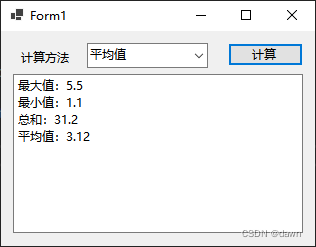

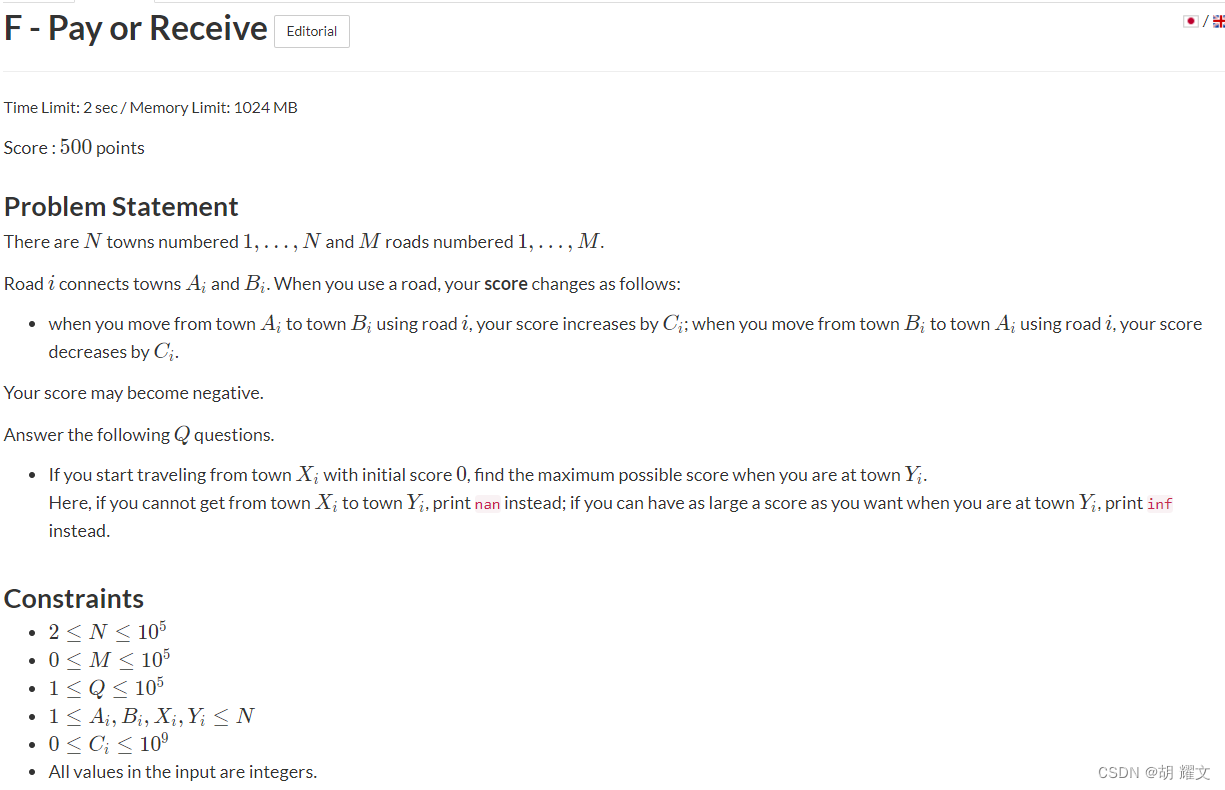
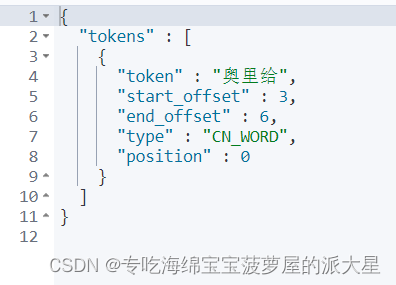
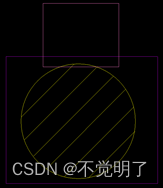

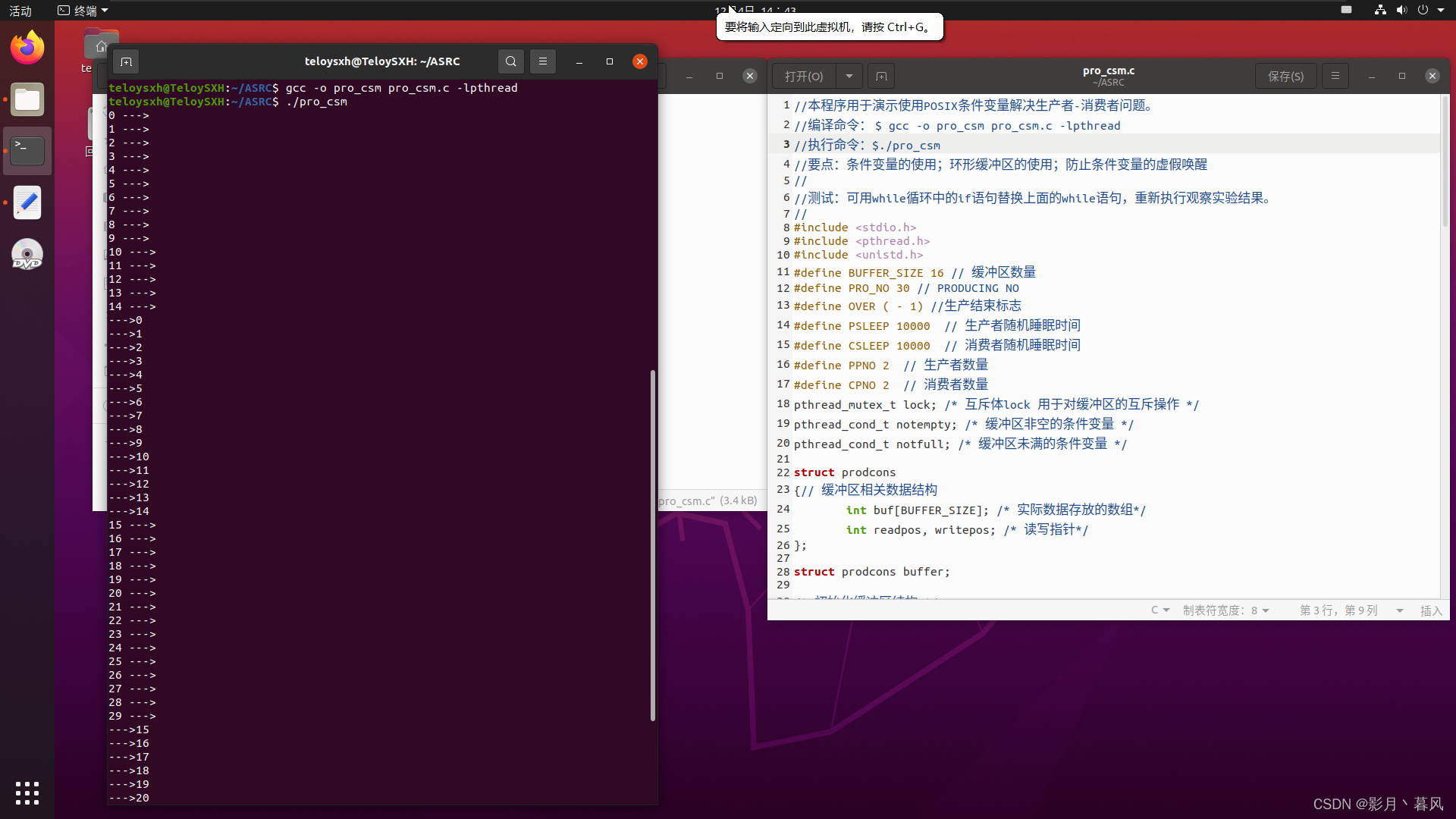

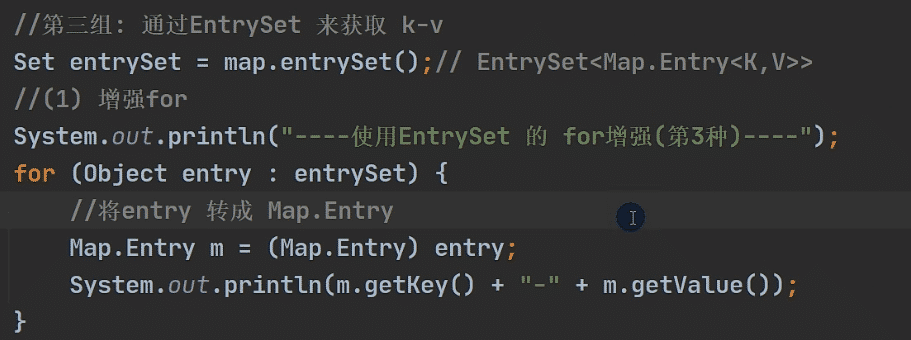

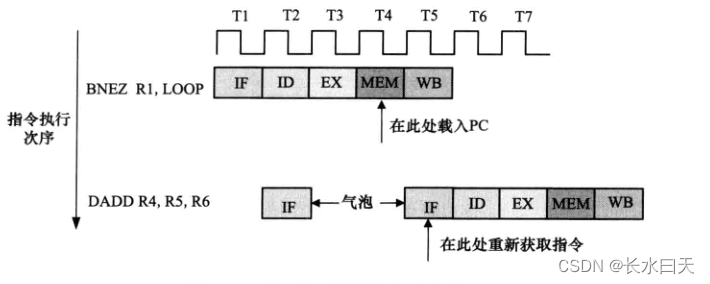
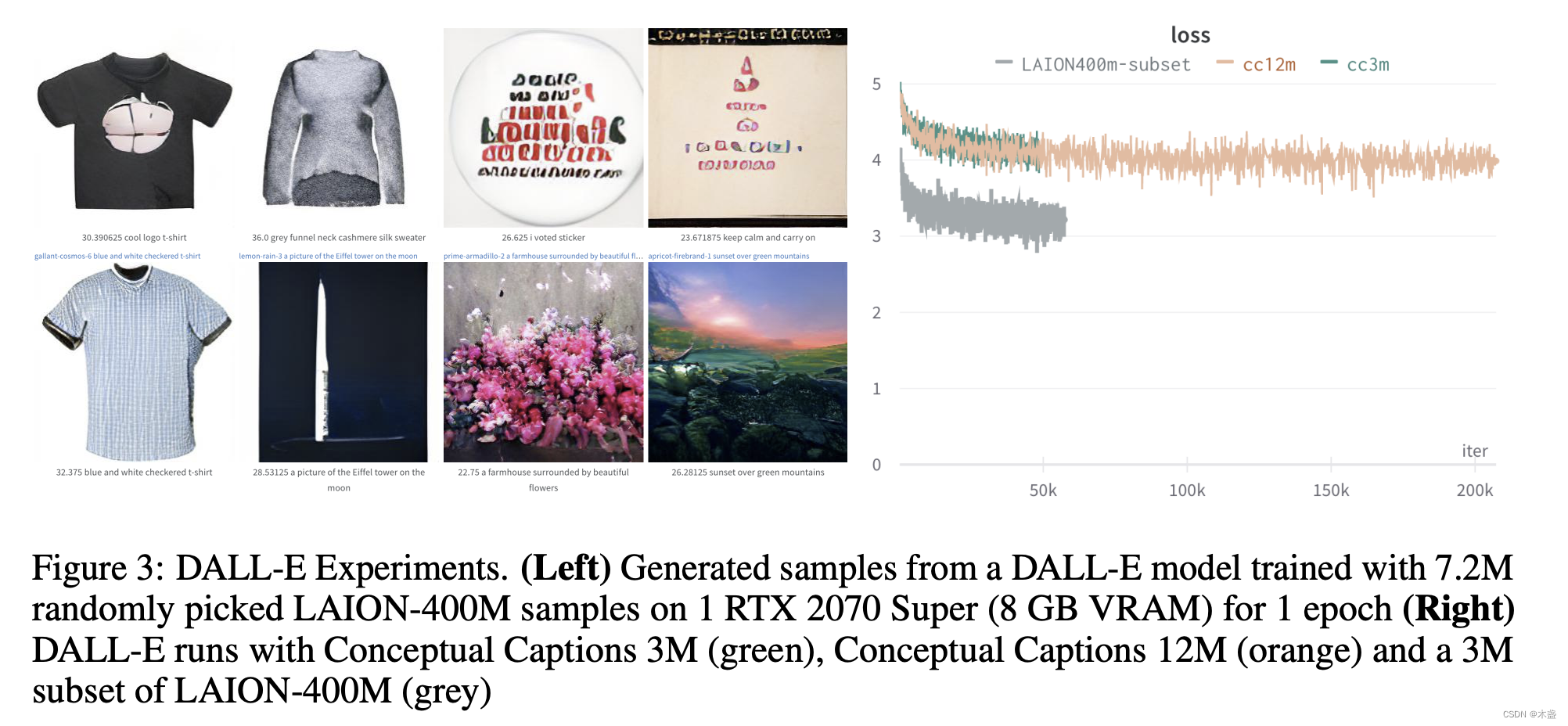


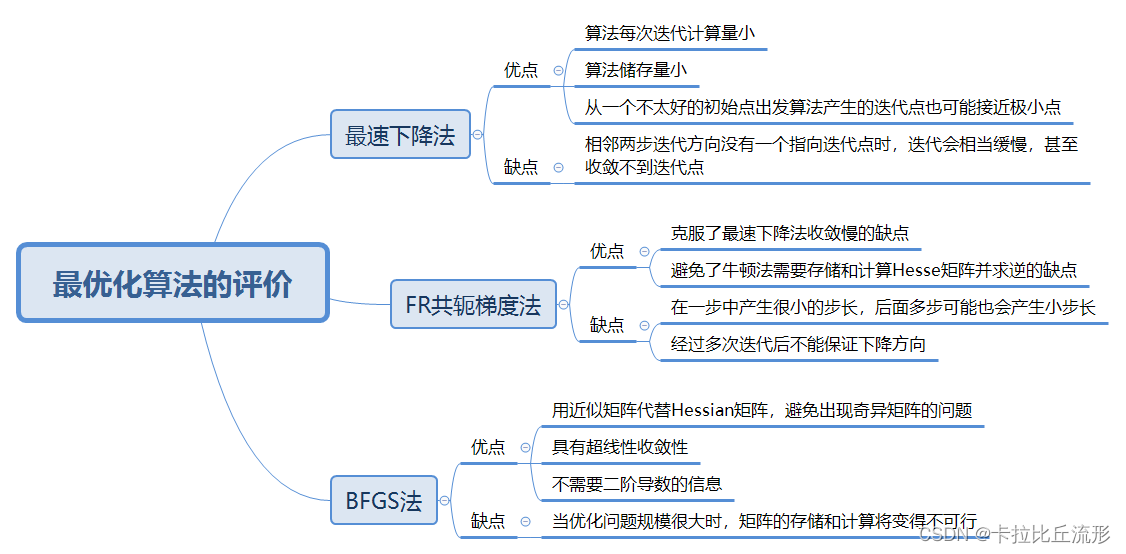
![[附源码]计算机毕业设计基于Springboot的中点游戏分享网站](https://img-blog.csdnimg.cn/98ff8829180a41329a838a8226c98889.png)
